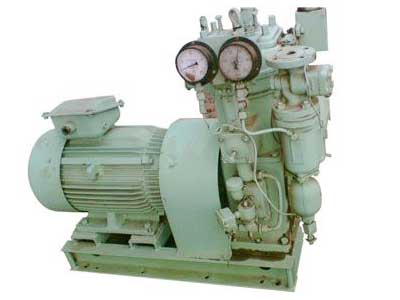Marine Air Compressor
A marine air compressor is an essential piece of machinery on ships, used to compress atmospheric air for various applications onboard.
📊 Main Uses:
-
Starting air for main and auxiliary engines
-
Control air for automation systems
-
Service air for general utility purposes (cleaning, maintenance tools, etc.)
-
Emergency air supply
📦 Key Components Visible:
-
Electric Motor (left side)
-
Drives the compressor pump via a direct or belt coupling.
-
-
Compressor Unit (right side)
-
The main air compression chamber — typically multi-stage (2 or 3-stage) for achieving high pressures efficiently.
-
-
Pressure Gauges (top)
-
Indicate the pressure at various stages or in the discharge line.
-
-
Oil Filter / Separator (upper section)
-
Removes oil mist from compressed air.
-
-
Intercoolers / Aftercoolers (integrated, not clearly visible)
-
Cools the air between stages and after final compression to reduce temperature and moisture content.
-
-
Safety Valves
-
Release excess pressure to prevent damage or hazards.
-
📌 Working Principle (Brief)
-
Air intake via a filter.
-
Compression in stages — cooled after each stage via intercoolers.
-
Final compressed air passes through an oil separator and aftercooler.
-
Stored in starting air bottles or supplied to ship systems.
A marine air compressor is a crucial piece of equipment on ships, providing compressed air for various functions like starting engines, powering pneumatic tools, and operating safety systems. It compresses air using methods like reciprocating, rotary screw, or centrifugal mechanisms. This compressed air is then stored in a receiver for later use.

